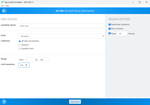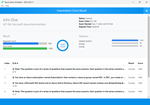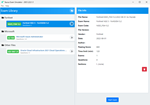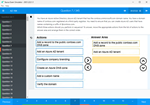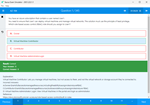Download CompTIA CSA+.CS0-003.DumpsMate.2025-04-29.228q.tqb
| Vendor: | CompTIA |
| Exam Code: | CS0-003 |
| Exam Name: | CompTIA CSA+ |
| Date: | Apr 29, 2025 |
| File Size: | 13 MB |
How to open TQB files?
Files with TQB (Taurus Question Bank) extension can be opened by Taurus Exam Studio.
Purchase
Coupon: TAURUSSIM_20OFF
Discount: 20%
Demo Questions
Question 1
Which of the following would a security analyst most likely use to compare TTPs between different known adversaries of an organization?
- MITRE ATTACK
- Cyber Kill Cham
- OWASP
- STIXTAXII
Correct answer: A
Explanation:
MITRE ATT&CK is a framework and knowledge base that describes the tactics, techniques, and procedures (TTPs) used by various adversaries in cyberattacks. MITRE ATT&CK can help security analysts compare TTPs between different known adversaries of an organization, as well as identify patterns, gaps, or trends in adversary behavior. MITRE ATT&CK can also help security analysts improve threat detection, analysis, and response capabilities, as well as share threat intelligence with other organizations or communities MITRE ATT&CK is a framework and knowledge base that describes the tactics, techniques, and procedures (TTPs) used by various adversaries in cyberattacks. MITRE ATT&CK can help security analysts compare TTPs between different known adversaries of an organization, as well as identify patterns, gaps, or trends in adversary behavior. MITRE ATT&CK can also help security analysts improve threat detection, analysis, and response capabilities, as well as share threat intelligence with other organizations or communities
Question 2
A security analyst is reviewing the logs of a web server and notices that an attacker has attempted to exploit a SQL injection vulnerability.
Which of the following tools can the analyst use to analyze the attack and prevent future attacks?
- A web application firewall
- A network intrusion detection system
- A vulnerability scanner
- A web proxy
Correct answer: A
Explanation:
A web application firewall (WAF) is a tool that can protect web servers from attacks such as SQL injection, cross-site scripting, and other web-based threats. A WAF can filter, monitor, and block malicious HTTP traffic before it reaches the web server. A WAF can also be configured with rules and policies to detect and prevent specific types of attacks.References: CompTIA CySA+ Study Guide: Exam CS0-002, 2nd Edition, Chapter 3, “Security Architecture and Tool Sets”, page 91; CompTIA CySA+ Certification Exam Objectives Version 4.0, Domain 1.0 “Threat and Vulnerability Management”, Objective 1.2 “Given a scenario, analyze the results of a network reconnaissance”, Sub-objective “Web application attacks”, page 9CompTIA CySA+ Study Guide: Exam CS0-002, 2nd Edition : CompTIA CySA+ Certification Exam Objectives Version 4.0.pdf) A web application firewall (WAF) is a tool that can protect web servers from attacks such as SQL injection, cross-site scripting, and other web-based threats. A WAF can filter, monitor, and block malicious HTTP traffic before it reaches the web server. A WAF can also be configured with rules and policies to detect and prevent specific types of attacks.
References: CompTIA CySA+ Study Guide: Exam CS0-002, 2nd Edition, Chapter 3, “Security Architecture and Tool Sets”, page 91; CompTIA CySA+ Certification Exam Objectives Version 4.0, Domain 1.0 “Threat and Vulnerability Management”, Objective 1.2 “Given a scenario, analyze the results of a network reconnaissance”, Sub-objective “Web application attacks”, page 9
CompTIA CySA+ Study Guide: Exam CS0-002, 2nd Edition : CompTIA CySA+ Certification Exam Objectives Version 4.0.pdf)
Question 3
The Chief Executive Officer (CEO) has notified that a confidential trade secret has been compromised.
Which of the following communication plans should the CEO initiate?
- Alert department managers to speak privately with affected staff.
- Schedule a press release to inform other service provider customers of the compromise.
- Disclose to all affected parties in the Chief Operating Officer for discussion and resolution.
- Verify legal notification requirements of PII and SPII in the legal and human resource departments.
Correct answer: A
Explanation:
The CEO should initiate an alert to department managers to speak privately with affected staff. This is because the trade secret is confidential and should not be disclosed to the public. Additionally, the CEO should verify legal notification requirements of PII and SPII in the legal and human resource departments to ensure compliance with data protection laws.References: CompTIA CySA+ Study Guide: Exam CS0-002, 2nd Edition, Chapter 4, “Data Protection and Privacy Practices”, page 194; CompTIA CySA+ Certification Exam Objectives Version 4.0, Domain 4.0 “Compliance and Assessment”, Objective 4.1 “Given a scenario, analyze data as part of a security incident”, Sub-objective “Data classification levels”, page 23 The CEO should initiate an alert to department managers to speak privately with affected staff. This is because the trade secret is confidential and should not be disclosed to the public. Additionally, the CEO should verify legal notification requirements of PII and SPII in the legal and human resource departments to ensure compliance with data protection laws.
References: CompTIA CySA+ Study Guide: Exam CS0-002, 2nd Edition, Chapter 4, “Data Protection and Privacy Practices”, page 194; CompTIA CySA+ Certification Exam Objectives Version 4.0, Domain 4.0 “Compliance and Assessment”, Objective 4.1 “Given a scenario, analyze data as part of a security incident”, Sub-objective “Data classification levels”, page 23
Question 4
After completing a review of network activity. the threat hunting team discovers a device on the network that sends an outbound email via a mail client to a non-company email address daily at 10:00 p.m. Which of the following is potentially occurring?
- Irregular peer-to-peer communication
- Rogue device on the network
- Abnormal OS process behavior
- Data exfiltration
Correct answer: D
Explanation:
Data exfiltration is the theft or unauthorized transfer or movement of data from a device or network. It can occur as part of an automated attack or manually, on-site or through an internet connection, and involve various methods. It can affect personal or corporate data, such as sensitive or confidential information. Data exfiltration can be prevented or detected by using compression, encryption, authentication, authorization, and other controls1The network activity shows that a device on the network is sending an outbound email via a mail client to a non-company email address daily at 10:00 p.m. This could indicate that the device is compromised by malware or an insider threat, and that the email is used to exfiltrate data from the network to an external party. The email could contain attachments, links, or hidden data that contain the stolen information. The timing of the email could be designed to avoid detection by normal network monitoring or security systems. Data exfiltration is the theft or unauthorized transfer or movement of data from a device or network. It can occur as part of an automated attack or manually, on-site or through an internet connection, and involve various methods. It can affect personal or corporate data, such as sensitive or confidential information. Data exfiltration can be prevented or detected by using compression, encryption, authentication, authorization, and other controls1
The network activity shows that a device on the network is sending an outbound email via a mail client to a non-company email address daily at 10:00 p.m. This could indicate that the device is compromised by malware or an insider threat, and that the email is used to exfiltrate data from the network to an external party.
The email could contain attachments, links, or hidden data that contain the stolen information. The timing of the email could be designed to avoid detection by normal network monitoring or security systems.
Question 5
Which of the following would likely be used to update a dashboard that integrates…..
- Webhooks
- Extensible Markup Language
- Threat feed combination
- JavaScript Object Notation
Correct answer: D
Explanation:
JavaScript Object Notation (JSON) is commonly used for transmitting data in web applications and would be suitable for updating dashboards that integrate various data sources. It's lightweight and easy to parse and generate. JavaScript Object Notation (JSON) is commonly used for transmitting data in web applications and would be suitable for updating dashboards that integrate various data sources. It's lightweight and easy to parse and generate.
Question 6
An analyst receives an alert for suspicious IIS log activity and reviews the following entries:
2024-05-23
15:57:05 10.203.10.16 HEAT / - 80 - 10.203.10.17 DirBuster-1.0-RC1+(http://www.owasp.org/index.php
/Category:OWASP_DirBuster_Project)
Which of the following will the analyst infer from the logs?
- An attacker is performing network lateral movement.
- An attacker is conducting reconnaissance of the website.
- An attacker is exfiltrating data from the network.
- An attacker is cloning the website.
Correct answer: B
Explanation:
Comprehensive and Detailed Step-by-Step Explanation:The logs indicate that the OWASP DirBuster tool is being used. This tool is designed for directory brute-forcing to find hidden files or directories on a web server, which aligns with reconnaissance activities. The series of GET and HEAD requests further confirm directory and file enumeration attempts.References:CompTIA CySA+ Study Guide (Chapter 4: Reconnaissance Techniques)CompTIA CySA+ Objectives (Domain 1.3 Tools and Techniques) Comprehensive and Detailed Step-by-Step Explanation:The logs indicate that the OWASP DirBuster tool is being used. This tool is designed for directory brute-forcing to find hidden files or directories on a web server, which aligns with reconnaissance activities. The series of GET and HEAD requests further confirm directory and file enumeration attempts.
References:
- CompTIA CySA+ Study Guide (Chapter 4: Reconnaissance Techniques)
- CompTIA CySA+ Objectives (Domain 1.3 Tools and Techniques)
Question 7
A security analyst received an alert regarding multiple successful MFA log-ins for a particular user When reviewing the authentication logs the analyst sees the following:
Which of the following are most likely occurring, based on the MFA logs? (Select two).
- Dictionary attack
- Push phishing
- impossible geo-velocity
- Subscriber identity module swapping
- Rogue access point
- Password spray
Correct answer: BC
Explanation:
С. Impossible geo-velocity: This is an event where a single user's account is accessed from different geographical locations within a timeframe that is impossible for normal human travel. In the log, we can see that the user "jdoe" is accessing from the United States and then within a few minutes from Russia, which is practically impossible to achieve without the use of some form of automated system or if the account credentials are being used by different individuals in different locations.В. Push phishing: This could also be an indication of push phishing, where the user is tricked into approving a multi-factor authentication request that they did not initiate. This is less clear from the logs directly, but it could be inferred if the user is receiving MFA requests that they are not initiating and are being approved without their genuine desire to access the resources. С. Impossible geo-velocity: This is an event where a single user's account is accessed from different geographical locations within a timeframe that is impossible for normal human travel. In the log, we can see that the user "jdoe" is accessing from the United States and then within a few minutes from Russia, which is practically impossible to achieve without the use of some form of automated system or if the account credentials are being used by different individuals in different locations.
В. Push phishing: This could also be an indication of push phishing, where the user is tricked into approving a multi-factor authentication request that they did not initiate. This is less clear from the logs directly, but it could be inferred if the user is receiving MFA requests that they are not initiating and are being approved without their genuine desire to access the resources.
Question 8
Which of the following will most likely cause severe issues with authentication and logging?
- Virtualization
- Multifactor authentication
- Federation
- Time synchronization
Correct answer: D
Explanation:
Time synchronization issues can cause severe problems with authentication and logging. If system clocks are not properly synchronized, it can lead to discrepancies in log timestamps, making it difficult to correlate events across different systems. Additionally, time-related discrepancies can affect authentication mechanisms that rely on time-based tokens, such as those used in multifactor authentication, leading to failures and security gaps. Time synchronization issues can cause severe problems with authentication and logging. If system clocks are not properly synchronized, it can lead to discrepancies in log timestamps, making it difficult to correlate events across different systems. Additionally, time-related discrepancies can affect authentication mechanisms that rely on time-based tokens, such as those used in multifactor authentication, leading to failures and security gaps.
Question 9
During an incident, a security analyst discovers a large amount of Pll has been emailed externally from an employee to a public email address. The analyst finds that the external email is the employee's personal email. Which of the following should the analyst recommend be done first?
- Place a legal hold on the employee's mailbox.
- Enable filtering on the web proxy.
- Disable the public email access with CASB.
- Configure a deny rule on the firewall.
Correct answer: A
Explanation:
Placing a legal hold on the employee’s mailbox is the best action to perform first, as it preserves all mailbox content, including deleted items and original versions of modified items, for potential legal or forensic purposes. A legal hold is a feature that allows an administrator to retain mailbox data for a user indefinitely or for a specified period, regardless of the user’s actions or retention policies. A legal hold can be applied to a mailbox using Litigation Hold or In-Place Hold in Exchange Server or Exchange Online. A legal hold can help to ensure that evidence of data exfiltration or other malicious activities is not lost or tampered with, and that the organization can comply with any legal or regulatory obligations. The other actions are not as urgent or effective as placing a legal hold on the employee’s mailbox, as they do not address the immediate threat of data loss or compromise. Enabling filtering on the web proxy may help to prevent some types of data exfiltration or malicious traffic, but it does not help to recover or preserve the data that has already been emailed externally. Disabling the public email access with CASB (Cloud Access Security Broker) may help to block or monitor the use of public email services by employees, but it does not help to recover or preserve the data that has already been emailed externally. Configuring a deny rule on the firewall may help to block or monitor the network traffic from the employee’s laptop, but it does not help to recover or preserve the data that has already been emailed externally. Placing a legal hold on the employee’s mailbox is the best action to perform first, as it preserves all mailbox content, including deleted items and original versions of modified items, for potential legal or forensic purposes. A legal hold is a feature that allows an administrator to retain mailbox data for a user indefinitely or for a specified period, regardless of the user’s actions or retention policies. A legal hold can be applied to a mailbox using Litigation Hold or In-Place Hold in Exchange Server or Exchange Online. A legal hold can help to ensure that evidence of data exfiltration or other malicious activities is not lost or tampered with, and that the organization can comply with any legal or regulatory obligations. The other actions are not as urgent or effective as placing a legal hold on the employee’s mailbox, as they do not address the immediate threat of data loss or compromise. Enabling filtering on the web proxy may help to prevent some types of data exfiltration or malicious traffic, but it does not help to recover or preserve the data that has already been emailed externally. Disabling the public email access with CASB (Cloud Access Security Broker) may help to block or monitor the use of public email services by employees, but it does not help to recover or preserve the data that has already been emailed externally. Configuring a deny rule on the firewall may help to block or monitor the network traffic from the employee’s laptop, but it does not help to recover or preserve the data that has already been emailed externally.
Question 10
An analyst is conducting monitoring against an authorized team that win perform adversarial techniques. The analyst interacts with the team twice per day to set the stage for the techniques to be used. Which of the following teams is the analyst a member of?
- Orange team
- Blue team
- Red team
- Purple team
Correct answer: A
Explanation:
The correct answer is A. Orange team.An orange team is a team that is involved in facilitation and training of other teams in cybersecurity. An orange team assists the yellow team, which is the management or leadership team that oversees the cybersecurity strategy and governance of an organization. An orange team helps the yellow team to understand the cybersecurity risks and challenges, as well as the roles and responsibilities of other teams, such as the red, blue, and purple teams12.In this scenario, the analyst is conducting monitoring against an authorized team that will perform adversarial techniques. This means that the analyst is observing and evaluating the performance of another team that is simulating real-world attacks against the organization’s systems or networks. This could be either a red team or a purple team, depending on whether they are working independently or collaboratively with the defensive team345.The analyst interacts with the team twice per day to set the stage for the techniques to be used. This means that the analyst is providing guidance and feedback to the team on how to conduct their testing and what techniques to use. This could also involve setting up scenarios, objectives, rules of engagement, and success criteria for the testing. This implies that the analyst is facilitating and training the team to improve their skills and capabilities in cybersecurity12.Therefore, based on these descriptions, the analyst is a member of an orange team, which is involved in facilitation and training of other teams in cybersecurity.The other options are incorrect because they do not match the role and function of the analyst in this scenario.Option B is incorrect because a blue team is a defensive security team that monitors and protects the organization’s systems and networks from real or simulated attacks. A blue team does not conduct monitoring against an authorized team that will perform adversarial techniques, but rather defends against them345.Option C is incorrect because a red team is an offensive security team that discovers and exploits vulnerabilities in the organization’s systems or networks by simulating real-world attacks. A red team does not conduct monitoring against an authorized team that will perform adversarial techniques, but rather performs them345.Option D is incorrect because a purple team is not a separate security team, but rather a collaborative approach between the red and blue teams to improve the organization’s overall security. A purple team does not conduct monitoring against an authorized team that will perform adversarial techniques, but rather works with them345.References:Infosec Color Wheel & The Difference Between Red & Blue TeamsThe colors of cybersecurity - UW–Madison Information TechnologyRed Team vs. Blue Team vs. Purple Team Compared - U.S. CybersecurityRed Team vs. Blue Team vs. Purple Team: What’s The Difference? | VaronisRed, blue, and purple teams: Cybersecurity roles explained | Pluralsight Blog The correct answer is A. Orange team.
An orange team is a team that is involved in facilitation and training of other teams in cybersecurity. An orange team assists the yellow team, which is the management or leadership team that oversees the cybersecurity strategy and governance of an organization. An orange team helps the yellow team to understand the cybersecurity risks and challenges, as well as the roles and responsibilities of other teams, such as the red, blue, and purple teams12.
In this scenario, the analyst is conducting monitoring against an authorized team that will perform adversarial techniques. This means that the analyst is observing and evaluating the performance of another team that is simulating real-world attacks against the organization’s systems or networks. This could be either a red team or a purple team, depending on whether they are working independently or collaboratively with the defensive team345.
The analyst interacts with the team twice per day to set the stage for the techniques to be used. This means that the analyst is providing guidance and feedback to the team on how to conduct their testing and what techniques to use. This could also involve setting up scenarios, objectives, rules of engagement, and success criteria for the testing. This implies that the analyst is facilitating and training the team to improve their skills and capabilities in cybersecurity12.
Therefore, based on these descriptions, the analyst is a member of an orange team, which is involved in facilitation and training of other teams in cybersecurity.
The other options are incorrect because they do not match the role and function of the analyst in this scenario.
Option B is incorrect because a blue team is a defensive security team that monitors and protects the organization’s systems and networks from real or simulated attacks. A blue team does not conduct monitoring against an authorized team that will perform adversarial techniques, but rather defends against them345.
Option C is incorrect because a red team is an offensive security team that discovers and exploits vulnerabilities in the organization’s systems or networks by simulating real-world attacks. A red team does not conduct monitoring against an authorized team that will perform adversarial techniques, but rather performs them345.
Option D is incorrect because a purple team is not a separate security team, but rather a collaborative approach between the red and blue teams to improve the organization’s overall security. A purple team does not conduct monitoring against an authorized team that will perform adversarial techniques, but rather works with them345.
References:
- Infosec Color Wheel & The Difference Between Red & Blue Teams
- The colors of cybersecurity - UW–Madison Information Technology
- Red Team vs. Blue Team vs. Purple Team Compared - U.S. Cybersecurity
- Red Team vs. Blue Team vs. Purple Team: What’s The Difference? | Varonis
- Red, blue, and purple teams: Cybersecurity roles explained | Pluralsight Blog
HOW TO OPEN VCE FILES
Use VCE Exam Simulator to open VCE files
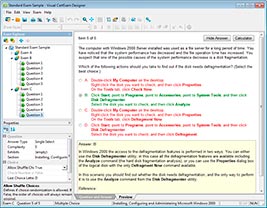
HOW TO OPEN VCEX FILES
Use ProfExam Simulator to open VCEX files
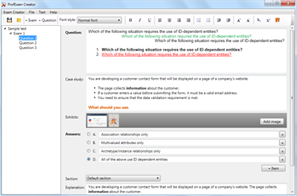
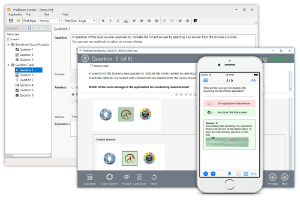
ProfExam at a 20% markdown
You have the opportunity to purchase ProfExam at a 20% reduced price
Get Now!